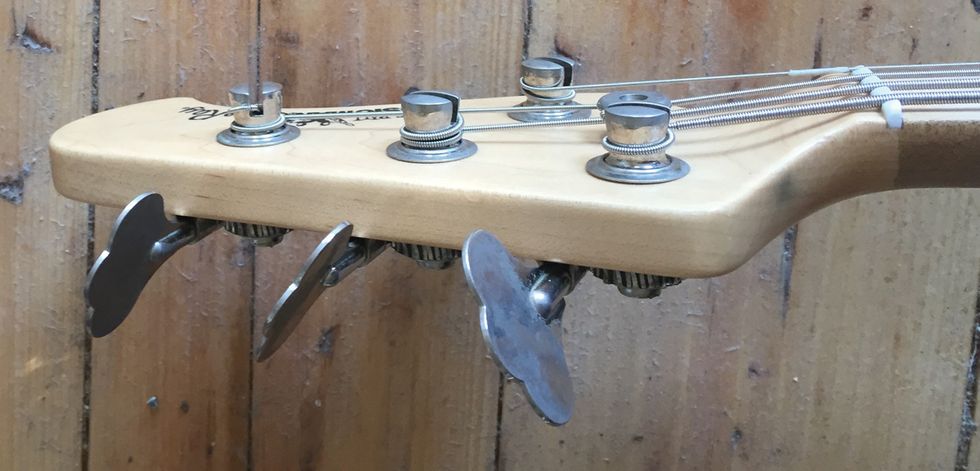It's revealing to research “headstock design" online. To me, the word design implies deep knowledge of a given subject, thoughtful composition, and the chops to execute an idea. (That's similar to being a skilled musician, if you think about it.) Though you might find a few technical recommendations, such as “keep the path of the strings in line for tuning stability," googling “headstock design" typically yields suggestions on how to create a headstock shape that stands out well enough to build a recognizable trademark. Beyond that, you'll be told it's necessary to “choose between a straight or angled headstock," and pertaining to the latter, an angle of “14 to 17 degrees has proven to be best."
Digging further, you might find a press release, referenced in dozens of music-news platforms around the world, for a guitar company's “new and innovative" headstock design that promises remarkable advantages. (Though this design is applied to guitar, the principle is the same for a bass headstock.) This winged headstock tilts the 3+3 tuner layout upward by roughly 30 degrees—a patented design inspired by “modern jet-fighters and Italian supercars and their scissor doors." According to the builder, this change will improve a guitar's sustain, tone, and playability, reduce fret buzz, make string-bending easier, and even improve tuning stability. In fact, all these tilted wings do is raise the tuners, thus reducing the strings' break angle at the nut by a few degrees.
Experimenting with headstock break angle isn't new. The nut and bridge are a string's two anchor points, so we certainly can't neglect how it passes over them. That said, there's plenty of heated discussion in the luthier community about how much break angle actually influences tone and playability.
What makes this subject a bit complicated is the interplay between break angle, a string's downward pressure, and its friction at the nut. How do these interact to affect the string's attack, sustain, elasticity, and tuning stability? And if that isn't confusing enough, here's something else to ponder: Does any of this also apply to fretted notes?
Let's remember that ever since Leo Fender introduced the straight-neck design, we've all been playing instruments with mixed string-break angles. Leo's all-in-line headstock meant that each string had its own break angle, and once this angle became too shallow to produce enough downward pressure to prevent the string from rattling within the nut slot, he simply threw in a string retainer to pull the 2nd and 1st strings down (Photo 1).
Photo 2 — Side view of a Music Man Sterling headstock with its shallow G-string break angle. Photo courtesy of basslab.de
The additional friction caused by a retainer is no friend of tuning stability, but it's hard to complain about a design that has sold so well for so long. Some bassists think the 3rd string on a P or J bass could also use a string retainer, which would eliminate the need to use so many windings to push that string down toward the headstock. And though Leo finally incorporated one on the Music Man StingRay's 3 +1 headstock design, this simply shifted the Fender's problematic 3rd to the Music Man's 1st string (Photo 2).
If you want to further explore the interplay between break angle, downward pressure, and friction, here's an idea: String up your bass with identical strings tuned to the same pitch. (So you don't have to mod the nut-slot width, simply install higher strings in the lower positions.) Now play and observe how identically gauged strings tuned to the same pitch perform with different break angles. Among other things, you might discover that a steeper angle, which causes more downward pressure and therefore higher friction, will result in the string feeling stiffer. That's because it no longer slips as easily over the nut, and this can impact elasticity and sometimes tuning stability.
Finally, this whole idea of achieving an even break angle for all strings is rather new. Perhaps it's a solution in search of a problem? After all, even the electric bass' predecessor—the upright bass—has always had mixed break angles.









![Rig Rundown: AFI [2025]](https://www.premierguitar.com/media-library/youtube.jpg?id=62064741&width=1245&height=700&quality=70&coordinates=0%2C0%2C0%2C0)












 Shop Scott's Rig
Shop Scott's Rig


![Rig Rundown: Russian Circles’ Mike Sullivan [2025]](https://www.premierguitar.com/media-library/youtube.jpg?id=62303631&width=1245&height=700&quality=70&coordinates=0%2C0%2C0%2C0)












































